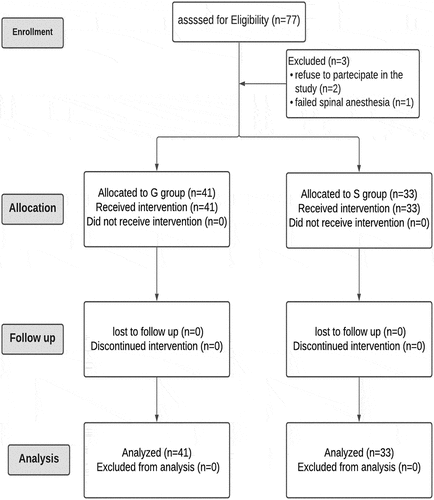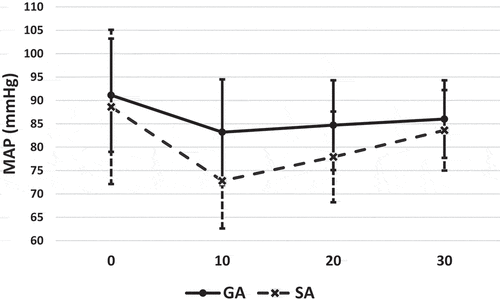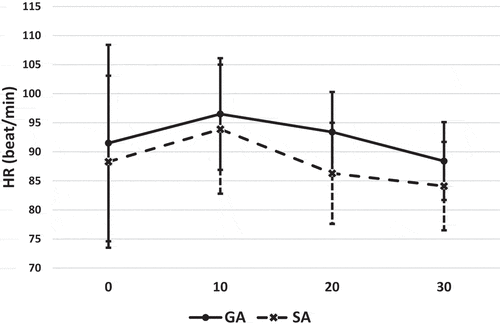ABSTRACT
Background: There are some advantages and drawbacks of both spinal (SA) and general anaesthesia (GA) used for caesarean section (CS) and there is no fully perfect process. Although GA is still the first choice for category‑1 emergency CS because of time constraints, but this technique poses several problems. This study was planned to compare maternal and fetal results in women undergoing emergent CS with spinal or general anesthesia.
Materials and Methods: This study took place at Benha University Hospital during the period from August 2020 to February 2021. It included 74 patients who had emergency CS and were subdivided into 2 groups according to the appropriate clinical indications. Patient features, CS indication, decision-to-delivery interval (DDI), uterine incision-to delivery (UIDT), cord blood pH, Apgar scores, length of hospital stay (LOS) and maternal morbidity have been noted.
Results: 74 patients were included in the analysis of total 77 patients underwent category 1 CS. The DDI and UIDT were not significantly different. One and 5-min Apgar scores were significantly higher in SA group compared to GA group. The umbilical cord blood pH showed no difference. No differences were noted between both groups regarding neonatal and maternal morbidity postoperative.
Conclusion: GA may be considered the fastest anaesthesia procedure in emergency situations, as it eliminates the risk of a failed regional block. In the meantime, the danger to mother or fetus is higher. Thus, we recommend regional anesthesia wherever possible due to better outcome regarding APGAR score and LOS.
1. Introduction
Cesarean section (CS) is now one of the world’s most common surgeries. According to the 2014 Egypt Demographic and Health Survey documented that Egypt ranked 3rd among the world’s countries with a reported Cesarean section rate of 51.8% [Citation1].
The four-point classification of urgency of CS used by the National Confidential Enquiry into Perioperative Deaths are: Category one – immediate threat to life of the mother or fetus, Category two – maternal or fetal compromise, not immediately life‑threatening, Category three – need early delivery but no maternal or fetal compromise, Category four – at a time to suit the woman and maternity team [Citation2]. Spinal anesthesia (SA) is now the standard technique in category 2, 3, and 4 as it results in less maternal and neonatal morbidity than general anesthesia (GA), Grade‑A recommendation according to National Institute of Health and Clinical Excellence (NICE) [Citation3]. However, in category‑1 CS, rapid sequence general anesthesia (RSGA) is commonly used because this technique is faster to perform than SA [Citation4]. Nowadays, the 30-minutes decision-to-delivery interval (DDI) is the standard in current practice for women needing an immediate caesarean section [Citation5]. However, time limitation and high risk make both maternal and fetal outcomes rely on the anesthetist’s coordination diligence and the proper choice of anesthetic technique is of fundamental importance [Citation6]. Though several randomized trials have compared the maternal and fetal outcome between these two anesthetic techniques, the studies with respect to category 1 CS are limited. We hypothesized that SA can be superior to GA in terms of maternal and neonatal outcome for category 1 CS. Hence, this prospective observational study has been designed to study the effect of anesthetic technique on the maternal and fetal outcomes in category 1 CS.
2. Materials and methods
After approval of the Research Ethics Committee (REC) Board of faculty of medicine at Benha university (RC3.7.2020) and trial registration at clinicaltrials.gov (NCT04634981) prior to patient enrollment, this prospective non-randomized clinical trial was conducted at Benha university surgical hospital in Egypt, during a period from August 2020 till February 2021.
Seventy four pregnant female admitted to the operating room for urgent CS were included in this study. After obtaining written informed consent from each parturient, they were allocated into two groups: (Group G): received rapid sequence general anesthesia, and (Group S): received spinal anesthesia.
The study enrolled pregnant women with the following inclusion criteria: American Society of Anesthesiologists physical status (ASA) < III, Age 18–40 year, Gestational age>37 weeks, Emergency cesarean delivery and Singleton pregnancy. On the other hand, parturient who disagreed to participate in the study or had any of the following criteria: Twin pregnancy, Neurological impairment, Congenital fetal abnormality, body mass index more than 40 kg/m2 and sensitivity to medications used during the emergency CS were excluded from the study.
Preoperative assessment was performed in the labor room by the attending anesthesiologist and included physical examination, laboratory assessment (hemoglobin, serum creatinine levels, platelets count, prothrombin time and blood glucose levels), and physical status class evaluation by the American Society of Anesthesiologists classification.
The decision of the type of anesthetic technique (GA or SA) was decided by the attending anesthesiologist. GA was often considered for patients with fetal heart rate (FHR) less than 100, persistent deceleration pattern of FHR, suspected maternal coagulopathy, maternal sepsis, maternal cardiac disease and eclampsia. Meanwhile, unfasted patients and known previous difficult intubation event contradict general anesthesia.
Before induction of anesthesia intravenous (IV) ranitidine 50 mg was administered after establishing an IV access. On the operating table, hemodynamic parameters (ECG, noninvasive blood pressure and hemoglobin oxygen saturation) were monitored for all parturients throughout the surgery according to the standard departmental protocol.
3. Description of the techniques
For general anesthesia: patients were positioned with pelvic wedge. They were then preoxygenated with four vital capacity breaths as the patients’ abdomen was cleaned and draped. Then rapid sequence induction with precalculated doses of propofol and rocuronium (2 mg/kg & 0.9 mg/kg, respectively) was followed by endotracheal intubation. After delivery of the baby, fentanyl was administered. Later, anesthesia was maintained with isoflurane (1%).
For spinal anesthesia: all parturients were coloaded with 500 mL of colloid solution. In the left lateral position, the patients’ back was cleaned with povidone iodine. In the meantime, the spinal anesthetic drug and local anesthetic drug were prepared. After wiping povidone iodine with alcohol, a single rapid shot of 2.2 mL of 0.5% hyperbaric bupivacaine was administered intrathecally using 22 G spinal needle. Later, the patients were kept in supine position with pelvic wedge. Oxygen was administered using simple face mask till the delivery of the baby.
Intraoperatively, all patients were administered Ringer’s lactate. Blood pressure was recorded at 5-min intervals. Any blood pressure less than 20% of baseline was treated with boluses of 5 mg of ephedrine.
The primary outcome in current study was to evaluate the neonatal Apgar score at 5 minutes. All other data were reported as secondary outcomes including: Demographics; decision-to-delivery interval (DDI); time of anesthetic induction (time from start of anesthesia till induction complete by confirmation of endotracheal intubation in GA or adequate level of block to touch in SA); uterine incision-to-delivery time (UIDT); intraoperative heart rate; intraoperative mean arterial pressure; APGAR score at 1 min and umbilical cord blood sample which assessed by a neonatologist. Neonatal intensive care unit admission (NICU) was also recorded.
Postoperatively, all patients were followed for any postoperative complications, intensive care unit (ICU) admission and length of hospital stay (LOS).
4. Statistical analysis
SPSS software version 25 (IBM, Armonk, New York, United states) was used for data management and statistical analysis. Numerical data summarization was done using means and standard deviation. Percentages were used for categorical data summarization. Independent t test was used for comparison between both groups in regard to numerical data. Categorical data was compared using Chi-square test or Fisher’s exact test if appropriate. P-values < 0.05 were considered statistically significant.
5. Sample size
The sample size calculation was performed using G. power 3.1.0 based upon the results of previous trial [Citation7]. The calculation revealed that at least 30 patients required in each group to detect a significant change of 5 minute APGAR score at alpha value of 0.05 and 90% power of study. We enrolled 77 patients to overcome the possibility of dropout cases.
6. Results
The current study was conducted at Benha University Hospital from August 2020 till February 2021. From 77 women, three were not included in the study as two women refused participation and the other woman had failed spinal anesthesia. A total of 74 patients were included in the study, 33 allocated to spinal anesthesia group (S) and 41 allocated to general anesthesia group (G) ().
As regard demographics, no significant differences were noted ().
There were no significant differences between the studied groups regarding indication of cesarean section ().
() showed that there were no statistically significant differences between study groups as regards duration of surgery and duration of anesthesia.
Table 1. Comparison between the studied groups regarding maternal demographic data
Table 2. Indication of cesarean section in both groups
Table 3. Duration of surgery & anesthesia in both groups
() displays that there were statistically significant differences between study groups as regards to APGAR score at 1 minute (P = 0.009) and 5 minute (P = 0.029) with high mean among spinal anesthesia group (). Although umbilical cord PH showed higher values in group S but it was still insignificant.
Table 4. Comparison between the studied groups regarding neonatal data
Complications did not differ significantly between studied groups. However, the LOS was significantly lower in S group with p value (0.028). There were three mothers had to be admitted to the critical care unit (CCU) postoperatively. One parturient had premature rupture of membranes (PROM) and sepsis and she was on mechanical ventilation for 2 days; the other had diabetic ketoacidosis and the third had eclamptic fits postoperatively. The CCU admission was because of their preexisting comorbidity and not due to any adverse event during anesthesia and surgery. There was no maternal mortality ().
() expresses that; baseline MAP and HR did not differ significantly between both groups. However, BP is significantly lower in Spinal anesthesia at 10 and 20 min, meanwhile, HR was lower in S group but showed no statistical significant values (,).
Table 5. Maternal complications in both groups
Table 6. Comparison between the studied groups regarding maternal hemodynamic data
7. Discussion
Although the constant increase in the rate of caesarean delivery still has a higher maternal and neonatal morbidity and mortality correlated not only with surgical abilities but also with the anesthesia used [Citation8]. Although the current practice is shifted toward spinal anesthesia, there is still no single perfect surgical or anesthetic procedure to be used in the C-section [Citation7].
During GA, it may not be always possible to maintain a discrete balance between the MAC to prevent awareness in the mother and to prevent neonatal depression in an already compromised fetus. However, the anesthesiologists invariably will try to maintain adequate anesthetic depth in the mother which may lead to the placental transfer of anesthetic drugs (opioids, induction agents and inhalational agents), thereby influencing the neonatal outcome [Citation9]. The foeto-maternal ratios of anesthetic agents suggest minimal transfer across the placenta; however, in category 1 CS when the fetus is already compromised, it may be enough to cause neonatal depression [Citation10].
The observations in this study suggest that parturients receiving GA for category 1 CS had significantly low 1- and 5-min Apgar scores compared with parturients receiving SA. Our results were similar to Thangaswamy et al. who observed that GA for category 1 CS was found to be associated with low Apgar score at 1and 5 min [Citation11]. A retrospective cohort study was performed by Beckmann et al. on 533 term babies observed that babies born by category 1 GA CS were significantly more likely to score Apgar < 7 at 5 min [Citation10]. Algert et al stated that in infants needed intubation, a 5-min Apgar score of less than 7 was more frequent in delivery with general anesthesia than delivery with regional anesthesia [Citation6]. Few other studies have also reported that Apgar scores were significantly lower in neonates whose mothers received GA [Citation12–14].
On the other hand, Edipoglu and colleagues analyzed the outcomes of emergency caesarean sections and found reduced 1 min Apgar scores not reflected in 5-min Apgar scores or morbidity for regional anesthesia group [Citation15]. These variations are most likely due to patient selection strategies, as our study excluded pregnancies with suspected fetal abnormality thus reducing the risk for adverse events. Further studies had reported no variations between cases of general and regional anesthesia in the 1 min and 5-min Apgar scores [Citation16].
Other neonatal parameters such as cord blood pH, NICU admission and neonatal mortality were comparable with both the anesthetic techniques. Numerous studies have assessed the status of neonatal acid-base and its association with the anesthesia technique. Another study done on 647 cases with emergency caesarean section found that umbilical blood pH was significantly lower in general anesthesia (pH = 7.16) compared to PH in spinal anesthesia (pH = 7.24) [Citation17]. We observed a similar pattern in umbilical blood pH, with lower pH values in general anesthesia group (7.21) compared to (7.24) in spinal anesthesia group, this difference was not statistically significant (p > 0.05). In a study by Thangaswamy et al., umbilical cord blood pH was comparable between SA and GA for emergency CS [Citation11]. few other studies also found the same results [Citation12,Citation15] On the other hand, in cases of spinal anesthesia, Reynolds et al. reported low umbilical pH for preterm infants and linked it to the use of higher doses of ephedrine [Citation18]. In contrast to this, Beckmann et al. observed a significantly less pH in GA group [Citation10].
The DDI time is controversial; however, it is universally accepted to keep DDI within 30 min. The DDI in both SA and GA was comparable in our study, whereas Beckmann et al. reported a significantly shorter DDI in patients who received GA [Citation10].
The maternal parameters such as intraoperative vital signs, maternal morbidity and mortality and ICU admission were also comparable between GA and SA. But various degree hypotension can be observed when neuraxial anesthesia is given during caesarean section [Citation19].
The length of postoperative hospital stay was longer in Group GA when compared to Group SA. Our findings are similar to Havas et al. who reported a decrease in postoperative hospital stay after neuraxial anesthesia [Citation20]
The key limitation of the current research is its design, as we were unable to do randomization as we followed the medical indications required for emergency caesareans under the departmental protocol. However, this bias was possibly ruled out as DDI was comparable in both groups. Furthermore, the small sample sizes so further studies with adequate sample size are needed.
8. Conclusion
In emergency caesareans suggested for fetal distress, we found that no anesthetic technique was superior regarding fetal distress. But regarding LOS, APGAR and morbidity, we recommend regional anesthesia whenever possible. The adequacy and the safety of spinal anesthesia as an alternative to general anesthesia in category 1 CS needs to be clarified in further larger randomized trials.
Disclosure statement
No potential conflict of interest.
References
- Kandil M. The skyrocketing rate of cesarean section in Egypt. Glob Drugs Therap. 2018;3(4). doi: 10.15761/GDT.1000153
- Lucas DN1, Sm Y, Sm K, Holdcroft A, et al. Urgency of caesarean section: a new classification. J R Soc Med. 2000;93(7):346‑50.
- Gholitabar M, Ullman R, James D, et al. Caesarean section: summary of updated NICE guidance. Bmj. 2011;343(nov23 1):d7108.
- Kinsella SM, Walton B, Sashidharan R, et al. Category‑1 caesarean section: a survey of anaesthetic and peri‑operative management in the UK. Anaesthesia. 2010;65(4):362‑8.
- Royal College of Obstetricians and Gynaecologists. Classification of urgency of caesarean Section–A continuum of risk (Good practice no. 11). (2010)
- Algert CS, Bowen JR, Giles WB, et al. Regional block versus general anaesthesia for caesarean section and neonatal outcomes: a population-based study. BMC Med. 2009;71:20. PMID: 19402884.
- Prakash S, Singh K, Loha S, et al. Comparative study for maternal and fetal outcome in spinal anaesthesia and general anaesthesia for LSCS. Int J Recent Sci Res. 2015 Nov;6:7443–7446.
- Kolås T, Saugstad OD, Daltveit AK, et al. Planned cesarean versus planned vaginal delivery at term: comparison of newborn infant outcomes. Am J Obstet Gynecol. 2006;195(6):1538–1543.
- Zakowski MI, Geller A. The placenta anatomy, physiology and transfer of drugs. In: Chestnut H, Wong C, Tesn L, et al., editors. Chestnut’s obstetric anesthesia: principles and practice. 5th ed. Philadelphia: Elsevier Saunders; 2014. p. 55–74.
- Beckmann M, Calderbank S. Mode of anaesthetic for category 1 caesarean sections and neonatal outcomes. Aust N Z J Obstet Gynaecol. 2012;52(4):316–320.
- Thangaswamy CR, Kundra P, Velayudhan S, et al. Influence of anaesthetic technique on maternal and foetal outcome in category 1 caesarean sections–A prospective single-centre observational study. Indian J Anaesth. 2018;62(11):844.
- Shek NW, Lao TT, Chan KK. Mode of anaesthesia on fetal acid-base status at caesarean section. J Perinat Med. 2012;40(6):653–657.
- Anaesthesiology HF, Zahir J. Maternal and neonatal outcome after spinal versus general anaesthesia for caesarean delivery. Ann Pak Inst Med Sci. 2011;7(3):115–118.
- Chattopadhyay S, Das A, Pahari S. Fetomaternal outcome in severe preeclamptic women undergoing emergency cesarean section under either general or spinal anesthesia. J Pregnancy. 2014 January 1;2014:2014.
- Edipoglu IS, Celik F, Marangoz EC, et al. Effect of anaesthetic technique on neonatal morbidity in emergency caesarean.
- American Society of Anesthesiologists Task Force on Obstetric Anesthesia.Practice guidelines for obstetric anesthesia: an updated report by the American society of anesthesiologists task force on obstetric anesthesia.Anesthesiology.2007;106(4):843–863. PMID: 17413923
- Strouch ZY, Dakik CG, White WD, et al. Anesthetic technique for cesarean delivery and neonatal acid-base status: a retrospective database analysis. PMID: 25499813 Int J Obstet Anesth. 2015;241:22–29.
- Reynolds F, Seed PT. Anaesthesia for caesarean section and neonatal acid-base status: a meta-analysis. PMID: 15960713 Anaesthesia. 2005;60 7:636–653.
- Kyokong O, Charuluxananan S, Sriprajittichai P, et al. The incidence and risk factors of hypotension and bradycardia associated with spinal anesthesia. J Med Assoc Thai. 2006;89(Suppl 3):S58–64.
- Havas F, Orhan Sungur M, Yenigün Y, et al. Spinal anesthesia for elective cesarean section is associated with shorter hospital stay compared to general anesthesia. Agri. 2013 January 1;25(2):55–63.




